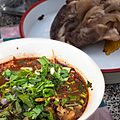Tendon as food facts for kids
Tendons are strong, stretchy parts in animals that connect muscles to bones. Think of them like super strong ropes! In many Asian countries, especially in places like China, Japan, and Vietnam, people use tendons from animals, often beef tendon, as a special ingredient in their cooking.
Even though tendons start out tough and chewy, they become wonderfully soft and tender after being cooked for a long time. Sometimes they are boiled for many hours, and other times they are deep-fried until crispy. Tendons have a lot of something called collagen. When cooked, this collagen makes them feel smooth and rich in your mouth, almost like a fatty piece of meat, even though they don't have much fat themselves. Some people say deep-fried tendon tastes a bit like chicharrón, which is fried pork belly.
Contents
Culinary Uses of Tendon
Tendon in Chinese Food
In Chinese cuisine, a popular dish is called suànbào niújīn. This dish features tendon that has been soaked in garlic. You can often find it served at dim sum restaurants, which are famous for small, tasty dishes.
Tendon in Indonesian Food
Indonesian cuisine uses tendon in several interesting ways. For example, bakso urat is a type of beef meatball that has small pieces of tendon inside. Another dish is soto kaki, which is a spicy soup made with cow's leg, including its tendons. There's also mie kocok, a noodle dish that includes meatballs, bean sprouts, and pieces of beef tendon.
Tendon in Japanese Food
In Japanese cuisine, beef tendon is known as gyū-suji. It's a common ingredient in a popular hot pot dish called oden. This dish is often eaten in colder weather.
Tendon in Korean Food
In Korean cuisine, beef tendon is called soesim. While not super common, it can be eaten raw as hoe or stir-fried as namul. The most popular way to enjoy beef tendon in Korea is to steam it under high pressure until it's very soft. People often eat these steamed tendons with green onions and soy sauce, or sometimes they are added to a rich ox bone soup.
Tendon in Thai Food
In Thai cuisine, tendon, known as เอ็น, is often added to delicious noodle soups. A good example is Guay tiew nuea toon, a flavorful beef noodle soup.
Tendon in Vietnamese Food
In Vietnamese cuisine, tendon is a common ingredient in pho, a famous Vietnamese noodle soup. It adds a unique texture and flavor to this beloved dish.
Images for kids
-
Indonesian mie kocok noodle dish uses pieces of beef tendon.





